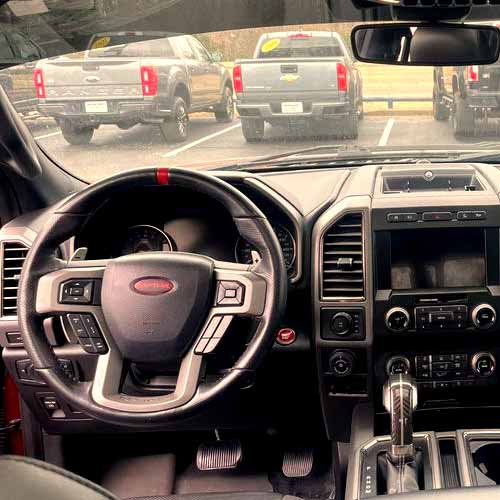All-terrain tires are a popular choice among off-road enthusiasts for their ability to provide good traction and durability on a variety of surfaces. However, one of the common complaints about these types of tires is the presence of vibrations. This can be caused by a number of factors related to the design and construction of the tire, as well as the condition of the vehicle and its alignment.

All-terrain tires basically has more number of plies in their internal structure, with 3 ply polyester casing, and 2 wide steel belts on top, further covered with 2 cap plies of nylon, these tires get to be pretty stiff. And despite having larger tread depth, they are not able to cushion the bumps in a better way, causing vibrations. Moreover, the aggressive tread pattern of lugs having large tread voids, make inconsistent contact with the road which also makes the ride bumpier. Though there are still some all-terrain tires out there, which provide satisfactory results in this department.
Table of Contents
What causes vibrations in all-terrain tires?
The design and construction of all-terrain tires can affect how they perform on the road. Factors such as the tread pattern, rubber compound, and tire size and aspect ratio can all contribute to vibrations. I’ve discussed them all below.
Tread Pattern
All-terrain tires have wider tread voids, and these basically generate more vibrations due to compound having enhanced elasticity.
The larger spaces between the tread blocks allow for more movement of the tread as it comes into contact with pavements. This added flexibility causes the lugs to bend more, creating vibrations (that can even be felt in the steering wheel).
Moreover, these wider grooves also make it difficult for the tread to make a consistent connection with the surface, decreasing overall stability, and and with it comfort.
(Though comfort also depends on tread noise, and I covered that one here).
Tread Depth
Tread depth can also cause a lot of vibrations, if the the lugs are not supported.
Although some of the all-terrain tires have higher tread depth, with supporting reinforced foundations and ridges, they still don’t allow the blocks to move that much, keeping them firm.
While others which are left unsupported can bring about more vibrations on higher speeds and during cornering and braking.
Tread Composition
The tread compounds typically include different types of polymers such as natural rubber, synthetic rubber, and other materials such as carbon black, silica, and various oils and fillers.
A tread compound that includes a higher percentage of natural rubber will be softer and more “bending” compared to the composition that has larger synthetic rubber density.
Therefore, the composition of the tread on all-terrain tires can affect vibrations on the road, and the choice of polymers can vary the durability, flexibility, and wear resistance of the tire which in turn decreases overall comfort.
How to reduce vibrations caused by all-terrain tires?
So we learned A/T tires aren’t the most comfortable, but what can be done about it? Let’s find out.
Check Tread Wear
So this is the first things that you do. Make sure you check out the tread depth on all tires, you can do this simply by using a penny.
As tires wear down, the tread depth decreases and this can negatively affect the tire’s ability to grip the road surface, leading to more vibrations.
That’s why I recommend checking tread depth of tires at least once a month. And if tread is worn down to 2/32″, it’s time to get them replaced.
For Your Info: Some tires have tread wear indicators, and these further make things easier. These indicators are basically small ridges and you measure the span between their height and that of the tread. And once they both get to match up, it’s time to change, as they are mostly 2/32″.
Check Alignment and Suspension
The second most important thing is to see if tires are properly aligned, as this not only causes a lot of different tread wear patterns, but is also one of the major cause of creating vibrations.
Basically if alignment is out, the other tires would be stressed (rub off with the road with uneven force), causing the ride to get bumpy.
I recommend getting tires aligned after every 6 month, at most.
Get Tires Rotated
In order to get smooth ride, the tires should have very minimal tread depth gap between them.
In FWD, tires on the front get to wear off faster, and the opposite happens on RWD, that’s why with tire rotation, the gap between the tires get minimized, and the smoothness of the tire is returned.
Similarly, keeping the same tire pressure also removes the uneven stress on the tires, so makes sure you get that right as well.
What is the most comfortable all-terrain tire?
Out of all, the Yokohama Geolandar G015 gives you the most comfortable ride, out of all.
That’s because the tire has a spongy rubber, and a good amount of thickness to it (it’s tread depth which reaches up to 17/32″ offers a lot of rubber matters between you and the surface).
Moreover, it’s internal construction consist of very malleable (only one) cap ply, which is also spirally wound.
All of these account for settling down the vibrations on road.
That’s why I added this tire in my list of best all terrains, check it out here: https://tiredriver.com/best-all-terrain-tires/
Summing Up
When it comes to al-terrain tires, you can expect some limited comfort overall, as their more number of plies internally causes an overall stiffness, resulting in less absorption of vibrations in the tread.
Moreover, with bigger grooves, especially on aggressive A/T tires, the tread isn’t able to make a consistent contact with the smooth surface, and this causes the ride to get bumpier.
But as A/Ts come in a large variety, there are some tires which are actually pretty great at cushioning the bumps, and out of them, the Yokohama G015 ranks on top.